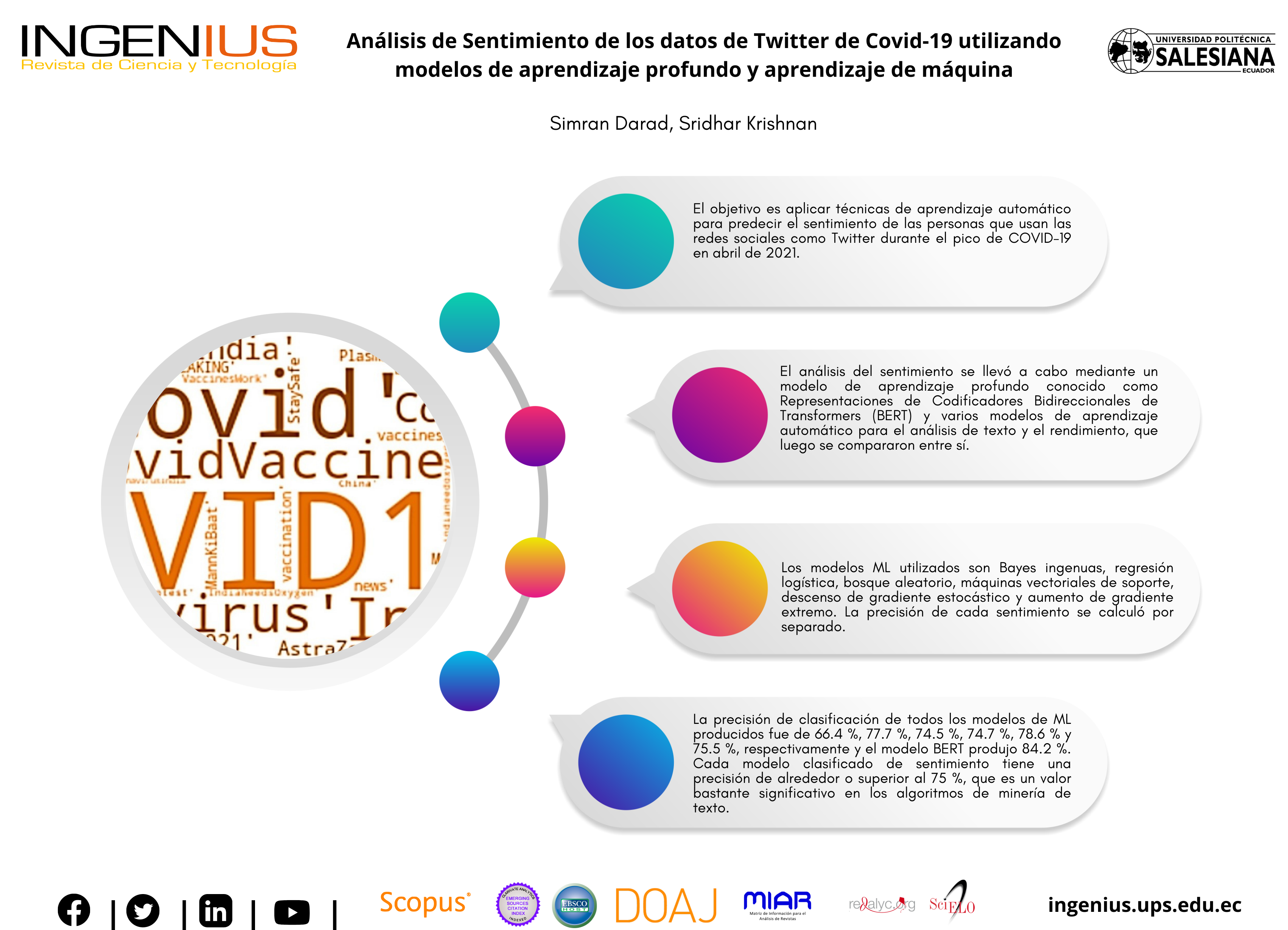Análisis de sentimiento de los datos de twitter de COVID-19 utilizando modelos de aprendizaje profundo y aprendizaje máquina
Contenido principal del artículo
Resumen
Detalles del artículo

Esta obra está bajo una licencia internacional Creative Commons Atribución-NoComercial-CompartirIgual 4.0.
La Universidad Politécnica Salesiana de Ecuador conserva los derechos patrimoniales (copyright) de las obras publicadas y favorecerá la reutilización de las mismas. Las obras se publican en la edición electrónica de la revista bajo una licencia Creative Commons Reconocimiento / No Comercial-Sin Obra Derivada 4.0 Ecuador: se pueden copiar, usar, difundir, transmitir y exponer públicamente.
El autor/es abajo firmante transfiere parcialmente los derechos de propiedad (copyright) del presente trabajo a la Universidad Politécnica Salesiana del Ecuador, para las ediciones impresas.
Se declara además haber respetado los principios éticos de investigación y estar libre de cualquier conflicto de intereses.
El autor/es certifican que este trabajo no ha sido publicado, ni está en vías de consideración para su publicación en ninguna otra revista u obra editorial.
El autor/es se responsabilizan de su contenido y de haber contribuido a la concepción, diseño y realización del trabajo, análisis e interpretación de datos, y de haber participado en la redacción del texto y sus revisiones, así como en la aprobación de la versión que finalmente se remite en adjunto.
Referencias
T. Vijay, A. Chawla, B. Dhanka, and P. Karmakar, “Sentiment analysis on covid-19 twitter data,” in 2020 5th IEEE International Conference on Recent Advances and Innovations in Engineering (ICRAIE), 2020, pp. 1–7. [Online]. Available: https://doi.org/10.1109/ICRAIE51050.2020.9358301
M. Mansoor, K. Gurumurthy, A. R. U, and V. R. B. Prasad, “Global sentiment analysis of COVID-19 tweets over time,” CoRR, vol. abs/2010.14234, 2020. [Online]. Available: https://doi.org/10.48550/arXiv.2010.14234
H. Drias and Y. Drias, “Mining twitter data on covid-19 for sentiment analysis and frequent patterns discovery,” medRxiv, 2020. [Online]. Available: https://doi.org/10.1101/2020.05.08.20090464
F. Rustam, M. Khalid, W. Aslam, V. Rupapara, A. Mehmood, and G. S. Choi, “A performance comparison of supervised machine learning models for covid-19 tweets sentiment analysis,” PLOS ONE, vol. 16, no. 2, pp. 1–23, 02 2021. [Online]. Available: https://doi.org/10.1371/journal.pone.0245909
R. Lamsal, “Design and analysis of a large-scale COVID-19 tweets dataset,” Applied Intelligence, vol. 51, no. 5, pp. 2790–2804, May 2021. [Online]. Available: https://doi.org/10.1007/s10489-020-02029-z
A. D. Dubey, “Twitter sentiment analysis during covid-19 outbreak,” SSRN, 2021. [Online]. Available: https://dx.doi.org/10.2139/ssrn.3572023
N. Chintalapudi, G. Battineni, and F. Amenta, “Sentimental analysis of COVID-19 tweets using deep learning models,” Infect Dis Rep, vol. 13, no. 2, pp. 329–339, Apr. 2021. [Online]. Available: https://doi.org/10.3390/idr13020032
M. A. Kausar, A. Soosaimanickam, and M. Nasar, “Public sentiment analysis on twitter data during covid-19 outbreak,” International Journal of Advanced Computer Science and Applications, vol. 12, no. 2, 2021. [Online]. Available: http://dx.doi.org/10.14569/IJACSA.2021.0120252
A. Mitra and S. Bose, “Decoding Twitter-verse: An analytical sentiment analysis on Twitter on COVID-19 in india,” Impact of Covid 19 on Media and Entertainment, 2020. [Online]. Available: https://bit.ly/3YMj1c3
B. P. Pokharel, “Twitter sentiment analysis during covid-19 outbreak in nepal,” SSRN, 2020. [Online]. Available: https://dx.doi.org/10.2139/ssrn.3624719
C. R. Machuca, C. Gallardo, and R. M. Toasa, “Twitter sentiment analysis on coronavirus: Machine learning approach,” Journal of Physics: Conference Series, vol. 1828, no. 1, p. 012104, feb 2021. [Online]. Available: https://dx.doi.org/10.1088/1742-6596/1828/1/012104
S. Boon-Itt and Y. Skunkan, “Public perception of the COVID-19 pandemic on twitter: Sentiment analysis and topic modeling study,” JMIR Public Health Surveill, vol. 6, no. 4, p. e21978, Nov. 2020. [Online]. Available: https://doi.org/10.2196/21978
A. K. Uysal and S. Gunal, “The impact of preprocessing on text classification,” Information Processing & Management, vol. 50, no. 1, pp. 104–112, 2014. [Online]. Available: https://doi.org/10.1016/j.ipm.2013.08.006
S. Gujral, “Sentiment analysis: Predicting sentiment of COVID-19 tweets,” Analytics Vidhya, 2021. [Online]. Available: https://bit.ly/3j9tMVj
——, “Amazon product review sentiment analysis using bert,” Analytics Vidhya, 2021. [Online]. Available: https://bit.ly/3Vad9WE
B. Lutkevich. (2022) Bert language model. TechTarget Enterprise Al. [Online]. Available: https://bit.ly/3Wo5Pb4
J. Samuel, G. G. M. N. Ali, M. M. Rahman, E. Esawi, and Y. Samuel, “Covid-19 public sentiment insights and machine learning for tweets classification,” Information, vol. 11, no. 6, 2020. [Online]. Available: https://doi.org/10.3390/info11060314

